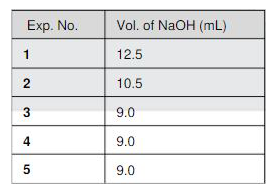Aqueous solution of orthoboric acid can be titrated against sodium hydroxide using phenolphthalein indicator only in presence of
trans-glycerol
catechol
cis-glycerol
both (b) and (c)
The correct Answer is:D
To solve the question regarding the titration of orthoboric acid with sodium hydroxide using phenolphthalein as an indicator, we can break it down into the following steps:
Step 1: Understand the Nature of Orthoboric Acid
Orthoboric acid (H₃BO₃) is a weak acid. It does not dissociate completely in water like strong acids do. Instead, it behaves more like a Lewis acid, forming a complex with hydroxyl ions.
Hint: Remember that weak acids do not fully dissociate in solution, which affects how we can titrate them.
Step 2: Identify the Role of Sodium Hydroxide
Sodium hydroxide (NaOH) is a strong base. When titrating a weak acid with a strong base, the equivalence point will occur when the amount of base added is stoichiometrically equivalent to the amount of acid present.
Hint: Strong bases can neutralize weak acids, but the presence of certain compounds can change the dynamics of the titration.
Step 3: Recognize the Importance of Indicators
Phenolphthalein is a pH indicator that changes color at a pH of around 8.2 to 10. In the titration of a weak acid with a strong base, the endpoint will occur at a higher pH than with strong acid-strong base titrations.
Hint: The choice of indicator is crucial; it must change color at the pH where the reaction reaches equivalence.
Step 4: Understand the Need for Polyhydroxyl Compounds
For the titration of orthoboric acid with sodium hydroxide using phenolphthalein, the presence of polyhydroxyl compounds (like cis-glycerol and catechol) is necessary. These compounds help to stabilize the formation of a cyclic complex with boric acid, thus increasing the effective concentration of hydronium ions (H⁺) in the solution.
Hint: Polyhydroxyl compounds enhance the acidity of the solution, allowing for a clearer endpoint when using phenolphthalein.
Step 5: Conclude the Answer
Therefore, the aqueous solution of orthoboric acid can be titrated against sodium hydroxide using phenolphthalein indicator only in the presence of polyhydroxyl compounds such as cis-glycerol and catechol. The correct answer to the question is that both catechol and cis-glycerol are required.
Final Answer: The titration can be performed in the presence of catechol and cis-glycerol (Option D).
Orthoboric acid (H₃BO₃) is a weak acid. It does not dissociate completely in water like strong acids do. Instead, it behaves more like a Lewis acid, forming a complex with hydroxyl ions.
Sodium hydroxide (NaOH) is a strong base. When titrating a weak acid with a strong base, the equivalence point will occur when the amount of base added is stoichiometrically equivalent to the amount of acid present.
Phenolphthalein is a pH indicator that changes color at a pH of around 8.2 to 10. In the titration of a weak acid with a strong base, the endpoint will occur at a higher pH than with strong acid-strong base titrations.
For the titration of orthoboric acid with sodium hydroxide using phenolphthalein, the presence of polyhydroxyl compounds (like cis-glycerol and catechol) is necessary. These compounds help to stabilize the formation of a cyclic complex with boric acid, thus increasing the effective concentration of hydronium ions (H⁺) in the solution.
Therefore, the aqueous solution of orthoboric acid can be titrated against sodium hydroxide using phenolphthalein indicator only in the presence of polyhydroxyl compounds such as cis-glycerol and catechol. The correct answer to the question is that both catechol and cis-glycerol are required.
Topper's Solved these Questions
- The p-Block Elements (Group 13 and Group 14)Book:DISHA PUBLICATIONChapter:The p-Block Elements (Group 13 and Group 14)Exercise:Exercise-1: Concept Builder (Topicwise) TOPIC 2: Carbon Family
Explore 28 Videos
- THE D- AND F- BLOCK ELEMENTS Book:DISHA PUBLICATIONChapter:THE D- AND F- BLOCK ELEMENTS Exercise:EXERCISE - 2 CONCEPT APPLICATOR
Explore 30 Videos
- THE P-BLOCK ELEMENTS (GROUP 15, 16, 17 & 18)Book:DISHA PUBLICATIONChapter:THE P-BLOCK ELEMENTS (GROUP 15, 16, 17 & 18)Exercise:Exercise
Explore 110 Videos
Similar Questions
Boric acid can be titrated against sodium hydroxide using phenolphthalein as an indicator only in the presence of polyhydroxy compounds like glycol. Glycerol etc. Give reason.
View SolutionBoric acid can be titrated against sodium hydroxide using methyl orange as indicator only in the presence of polyhydroxy compounds wlike catechol, manniton etc. explain.
View Solution
Knowledge Check
Compound (A) on reaction with iodine in the solvent diglyme gives a hydride (B) and hydrogen gas. The product (B) is instantly hydrolysed by water or aqueous alkali forming compound (C) and liberating hydrogen gas. The compound (C) in aqueous solution behaves as a week mono basic acid. But in presence of certain organic polyhydroxy compound behaves as a strong monobasic acid. The hydride (B) in air catches fire spontaneously forming oxide which gives coloured beads with transition metal compounds.
Aqueous solution of product (C) can be titrated against sodium hydroxide using phenolphthalein indicator only in presence of:Acis−1,2diolBtrans-1,2 diolCboraxDNa2HPO4Boric acid can be successfully titrated against sodium hydroxide in the presence of
Adil. HClBglycerolCglycineDborax.Aqueous solution of sodium carbonate can react with :
AMgCl2BCa(HCO3)2CH2SO4DCO2
Boric acid can be titrated against sodium hydroxide using methyl orange as indicator only in the presence of polyhydroxy compounds wlike catechol, manniton etc. explain.
View Solution5.00 mL of 0.10 M oxalic acid solution taken in a conical flask is titrated against NaOH from a burette using phenolphthalein indicator. The volume of NaOH required for the appearance of permanent faint pink color is tabulated below for five experiments. What is the concentration, in molarity, of the NaOH solution?

View SolutionName the salt formed when hydrochloric acid neutralises sodium hydroxide solution.
View SolutionName the product formed when acetic acid is treated with sodium hydroxide solution .
View SolutionIf a 25.0 mL sample of sulfuric acid is titrated with 50.0 mL of 0.025 M sodium hydroxide to a phenolphthalein endpoint, what is the molarity of the acid?
View Solution